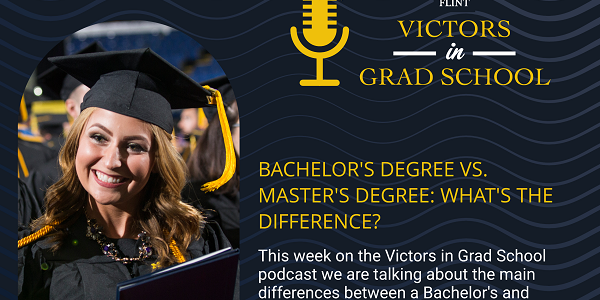When you think about a Bachelor’s degree and a Master’s degree, what comes to mind? Do you think about the length of time each takes, the depth of the content you will study, campus life, the overall experience or some other factor?
On a basic level, when looking at the differences in degrees, a Bachelor’s degree is typically a course of study that can take up to 120 credit hours, which can equate to eight semesters or four years of study. A Master’s degree is a degree beyond the Bachelor’s and is usually around 32-36 credit hours and can take from one to two years to complete.
Bachelor’s degrees provide students with a basic framework for academic achievement in a specific area of study. Master’s programs delve deeper beyond the general education (as you will take no general education courses during this) and focus on one specific targeted area of study.
What does a Bachelor’s Degree Contain?
Usually when looking at a Bachelor’s Degree you will find that you have two main type of degrees, a Bachelors of Arts (BA) and Bachelors of Science (BS). At some institutions you will find that there are other degrees outside of these, these two types of degrees tend to be the most common. As a part of your Bachelor’s degree, about half of the 120 credits will be general education courses. When we talk about general education, these courses include areas such as English composition, mathematics, social science, physical science, history, art, and culture among other areas.
At times students that are coming to a college/university will be undecided when it comes to a course of study, but they will usually select a major in their first few terms at the university. There will be times when a student must apply separately for a competitive undergraduate degree that might have limited seats in courses or in clinical rotations (Nursing, Education or other such programs).
The number of courses for a Bachelor’s degree can vary, but for many students, students are required to complete approximately 120 credits to graduate. To graduate students typically have to have a combination of general education courses, major courses and elective courses. Below you will see a possible breakdown of how a student might accomplish this.
| Course Types | Required Credits | Number of Required Courses |
| General Education Courses | 52 | 17 |
| Major Courses | 44 | 15 |
| Elective Courses | 24 | 8 |
| Total | 120 | 40 |

What does a Master’s Degree Contain?
Whereas in a Bachelor’s degree students have to complete general education courses, during a Master’s degree a student will focus completely on one subject/concentration area. Many times students will take a number of core courses in a specific discipline and then allow students to take additional courses in a specialization area. Some Master’s degrees will have students take part in internships or clinical experiences to allow students to be able to take the skills they are learning in their coursework and putting them to use.
| 36-Credit Master’s Program | |
| Required Classes | 12 |
| Average number of semesters | 3-4 |
| Average number of Classes Per Semester | 3-4 |
| Average Time to Completion | 12-24 months |
While Master of Arts and Master of Science are two of the most common degrees, there are a number of other degrees that colleges can also choose to offer that offer even more specialization.
Getting accepted to a Master’s program can be very competitive depending on the program. Some programs will have very specific pre-requisites or other requirements needed to be considered while other programs may be more generic in their approach to standards. It is always best for a student to thoroughly review admission requirements for any program that they are considering.
The University of Michigan-Flint offers a full array of Master’s and Doctorate programs for students interested in continuing their education. Click here to learn more.
Podcast: Play in new window | Download
